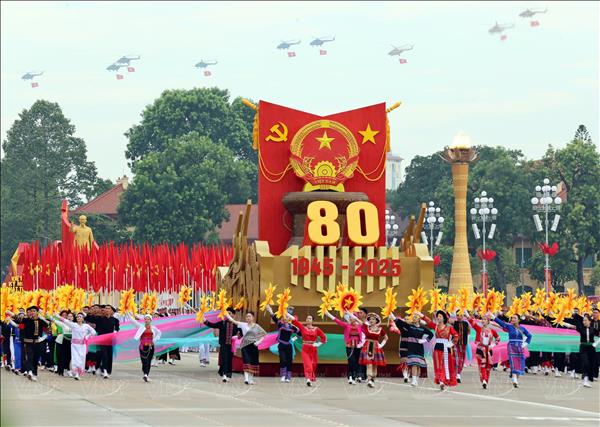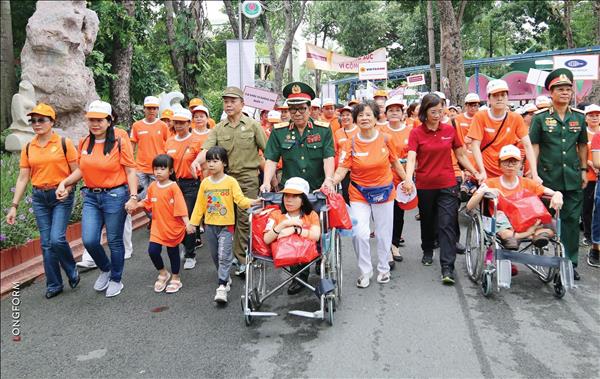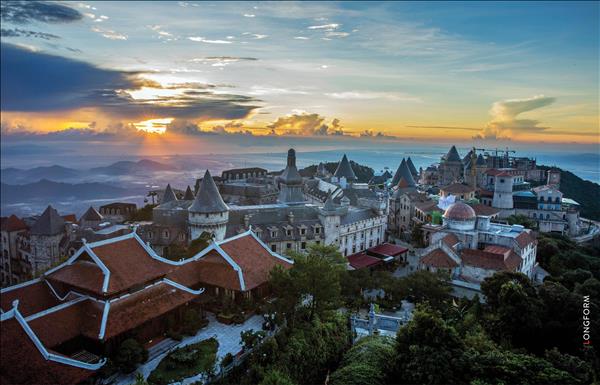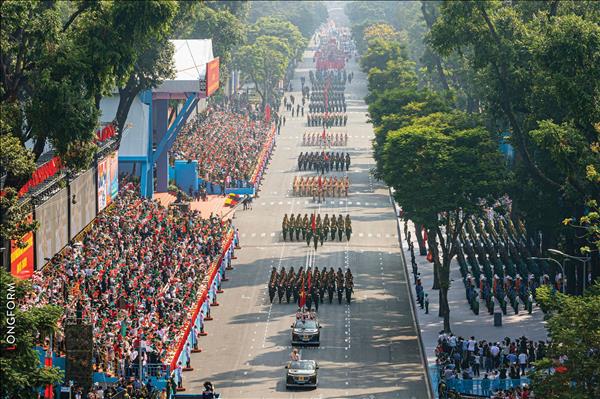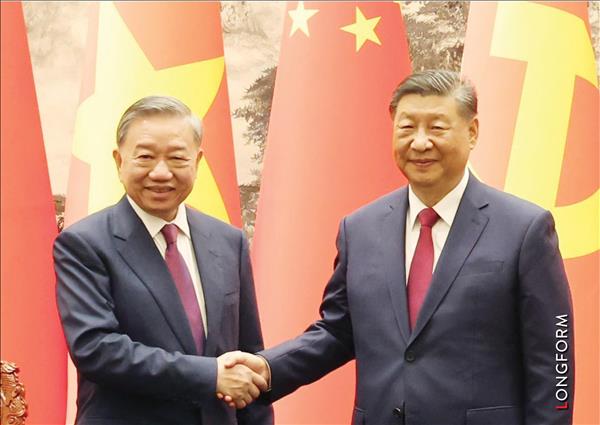|
Ten
years have passed since the article titled “General Vo Nguyen Giap – A
pan-century military marcher”, written by People’s Artist Dao Trong Khanh
for Vietnam Pictorial, was published on the occasion of the General’s
90th birthday in 2001. General Vo Nguyen Giap
began his 100th year on August 25,nbsp;2010 at the time when the whole country is preparing
for the Great Celebration of the 1,000th anniversary of Thang Long –
Hanoi
. On
this occasion, Vietnam Pictorial again introduces to readers the article,
written by People’s Artist Dao Trong Khanh, about the eminent general of
the nation, Vo Nguyen Giap.
|

General Vo Nguyen
Giap, a well-known general of the Vietnam People’s Army.
(Photo:
Tran Dinh)
|
|
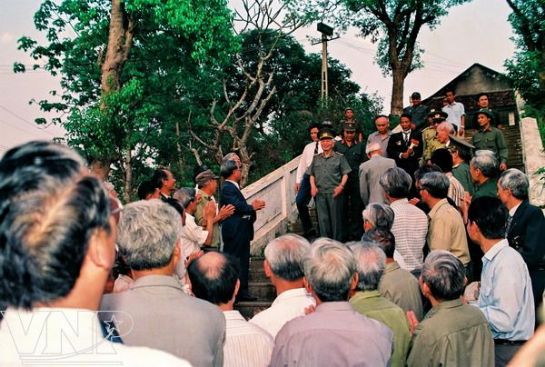
General Vo Nguyen Giap re-visits the former war
zone (Photo: Trong Thanh)
|
|

On April 6, 1994 General Vo Nguyen
Giap re-visited the headquarters of the defeated
French General
De Castries. (Photo: Trong Thanh)
|
|
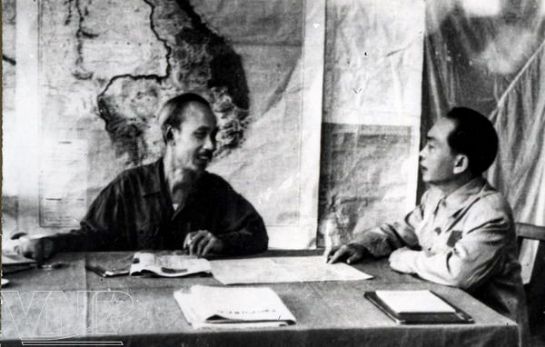
On behalf of the Party Central Committee and
the Government, President Ho Chi Minh entrusts General Vo Nguyen
Giap with a task to plannbsp;attacks and launch the Dien Bien Phu
Campaign. (Photo: VNA’s file)
|
|
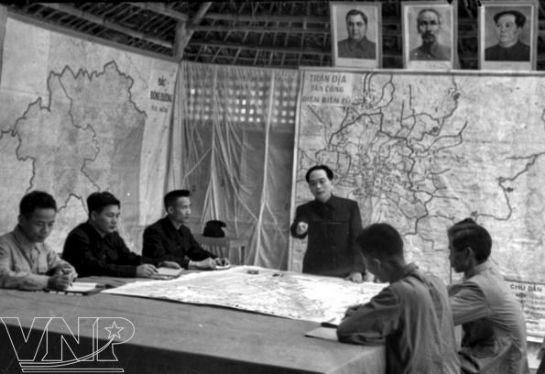
General Vo Nguyen Giap and the
General Staff of the Vietnam People’s Army work on
the plan for
attacks in the Dien Bien Phu Campaign (Photo: VNA’s file)
|
|
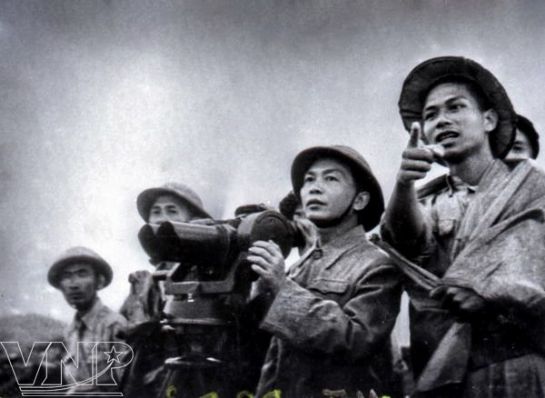
General Vo Nguyen Giap views the battlefield
before the launch of the Dien Bien Phu Campaign. (Photo: VNA’s file)
|
|
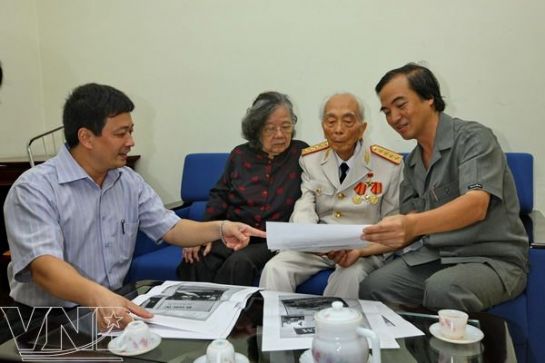
The Editorial Board of
Vietnam Pictorial shows General Vo Nguyen Giap the special issue of
Vietnam Pictorial to celebrate the 55th anniversary of Dien Bien Phu Victory
(May 2009).
|
|
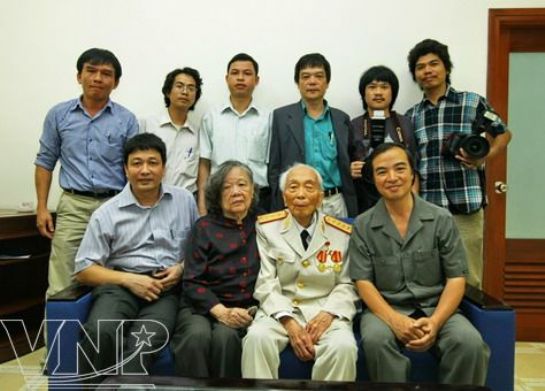
The Editorial Board and reporters
of Vietnam Pictorial posed for a souvenir photograph with the family
of General Vo Nguyen Giap on April 27, 2009.
|
|
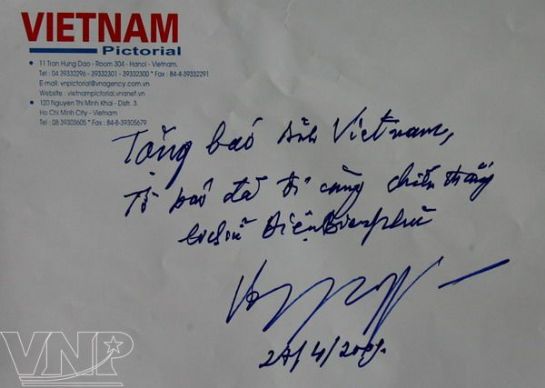
General Vo Nguyen Giap’s autograph
for Vietnam Pictorial on the occasion of
the 55th
anniversary of Dien Bien Phu Victory.
|
One day at the start of the year 2001, General vo
Nguyen Giap joyfully told us: “I’m a pan-century traveller.”
He was born on August 25, 1911 in the
village of
An
Xa, Le Thuy District,
Quang
Binh
Province in the year of Tan Hoi, when the Tan
Hoi Revolution broke out in
China
. As a poor little boy of
the country with “west wind, white sand”, he went to school, grew up,
joined the revolutionary movement, and became an outstanding general of
the Vietnamese Revolution. His life and career has been closely linked to
the history of formation, growth and development of the Vietnam People’s
Army. He was an excellent and close disciple of late President Ho Chi
Minh, and a close comrade-in-arms of the leaders of the Party and State of
Vietnam.
He remembers much about the
ancient capital of
Hue, where he was an
excellent student at the
National
College
, and where he had very
intimate friends who later became prominent revolutionaries such as Nguyen
Chi Dieu, Hai Trieu, Nguyen Khoa Van.
Expelled from the College for
his participation in the April 1927 school walkout, he taught himself,
wrote articles for the paper “Tieng dan” (People’s Voice) edited by the
patriot Huynh Thuc Khang and joined the “Tan Viet” (New Vietnam) Party. In
1930, he was arrested and indicted, then put under house arrest at his
home village.
One stormy day when the
Kien
Giang
River
rose high, the patriot Nguyen
Chi Dieu came in a little boat to get him. It was the day when he joined
the revolutionary movement.
He went to
Hanoi
, learning and
working for his own living, passed the exams as First Laureate in the
All-Indochina general examinations, held exclusively for excellent
students, then graduated as a Baccalaureate in Philosophy and Bachelor of
Laws with an excellent thesis.
Giap worked as a teacher
and a journalist while embarking on revolutionary activity. Duringnbsp;time off
from teaching at Thang Long Schoool, he wrote articles for the newspapers “Lao
Dong” (Labour), “Tin Tuc” (News), “Tieng Noi Cua Chung Ta” (Our Voice),
both in Vietnamese and French. During this period, he co-operated with
Truong Chinh in writing the book titled “Van De Dan Cay” (The question of
the tiller) under the pen-names of “Qua Ninh” and “Van Dinh”. In the
Indochina Congress Movement, he was elected Chairman of the Tonkin Press
Committee.
One afternoon, on
Co Ngu
Road
in
Hanoi, Hoang Van Thu, Secretary of the
Provisional Central Committee entrusted Giap and Pham Van Dong with the
mission to
Kunming (
China
)
to meet the Party leaders overseas. And on the shores of the romantic
Thuy
Ho
Lake
, they met a middle-aged
gentleman in a plain grey stiff-collar jacket. He was Nguyen Ai Quoc, a
member of the Communist International, who later became President Ho Chi
Minh.
The meeting left a profound
impression on him throughout his revolutionary career. He never forgot the
injunction by Nguyen Ai Quoc: “In embarking on revolutionary work, one
should put public affairs above everything!”
In May 1945, in the jungle of
Pac Bo, Nguyen Binh District, Cao Bang Province – the 8th
Session of the 1st Party Central Committee Plenum,
chaired by Ho Chi Minh decided to found the “Vietnam Doc Lap Dong Minh Hoi”,
known as “Viet Minh”. Vo Nguyen Giap was entrusted with controlling the Military
Division of the Viet Minh Central Committee, forming the armed forces in
preparation for insurrection to seize power.
The important turning point
that brought him to the post of a general commanding a people’s army was
the foundation on December 22, 1944, of the “Viet Nam Tuyen Truyen Giai
Phong Quan” (Vietnam Propaganda Liberation Army) in Tran Hung Dao Jungle
of Nguyen Binh District – Cao Bang Province, the predecessor to the
Vietnam People’ Army of today.
Only two days after its
foundation, under his command, the fledgling army recorded its first two
victories at Pay Khat and Na Ngan of Cao Bang Province.
Vo Nguyen Giap was appointed a
member of the Tonkin Revolutionary Military Committee, Commander-in-Chief
of the Vietnam Liberation Army and a member of the Provisional Command of
the Viet Bac Liberated Zone. The National Congress held at Tan Trao
elected him into the Vietnam National Liberation Committee. On behalf of
the Military Committee, Vo Nguyen Giap signed the order for general
insurrection. On the afternoon of August 16, 1945, upon the closing of the
Congress, under the age-old banyan tree, a unit of the Liberation Army
under the command of Vo Nguyen Giap held a ceremony before marching on to
Thai
Nguyen Town to fight the Japanese. “For the
moment, as the time is ripe, whatever sacrifices we have to make, even
though we have to set ablaze the Truong Son Range, we must resolutely win
national independence at all costs”. That was the injunction of President
Ho Chi Minh, then on his sickbed, given exclusively to Vo Nguyen Giap in a
thatched house of Na Lua, prior to the National Congress, both a sacred
sentiment and an urgent order for the commander-in-chief of the army in
his march to Hanoi.
The August General Insurrection
was victorious. The Provisional Government of the Democratic Republic of
Vietnam was formed. Vo Nguyen Giap held the posts of Minister of Home
Affairs and Vice Minister of Defence, building and safeguarding the
fledgling revolutionary power.
Then, taking cover behind the
British Army, the French troops opened fire to reconquer
Vietnam.
On December 19, 1946, the
resistance war against the French colonialists started. Vo Nguyen Giap was
appointed Commander-in-Chief of the National Army and the self-defence
militia forces.
He ordered general engagement
in all towns and cities with the invaders, fighting the adversary forces
in all corners of the land. The 60-day battle in the heart of the capital
city of
Hanoi
was one of the most gallant combats, ushering in the holy
9-year resistance war waged by the entire nation.
On January 2, 1948, President
Ho Chi Minh signed a decree, appointing him a General.
During the early years
of the resistance war, he created a compatible fighting approach of
his own, killing the enemy in parallel with building up his forces, making
full use ofnbsp;mobile guerilla warfare in coordination with small forces of the
regular troops. From the reality of the war, he sought out ways for his
fledgling army to dodge annihilation by an enemy with over-whelming
forces.
Throughout the nine years of the
resistance war, the Vietnam People’s Army was growing with every passing
day, defeating the French colonialists’ strategy of “lightning attacks,
lightning triumphs”, taking the strategic initiative on all battlefields,
and launching offensive and counteroffensive campaigns on an
ever larger scale on all battlefields. This resulted in the 1953-1954
Winter-Spring victory of the historic Dien Bien Phu Campaign that planted
“a brilliant golden landmark” and helped topple the strongholds of
colonialism worldwide.
In the nine-year resistance
war, his exceptionally prominent stamp lay in two major decisions of vital
significance, changing the target of the offensive from Cao Bang to Dong
Khe in the Borders Campaign (1950), and altering the guiding principle for
the operation of the campaign from “lightning attack, speedy settlement”
to “fighting firm, advancing firm “in the Dien Bien Phu Campaign. He often
said: “It was the most difficult decisions in all my life as a commander
of an army to fight the enemy!”.
In the long march against US
imperialism for national salvation, as a member of the Politburo and
Secretary of the Army Central Committee and Minister of National Defence,
he helped build a regular and modern army as a powerful support in the
struggle for national reunification, blazing the “Duong Truong Son”
(Truong Son Trail) to send reinforcements to the battle fronts in the
South and defeating the US air and naval war of destruction against the
North.
In the Spring of 1975, the Ho
Chi Minh Campaign won great victory, with the total collapse of the
Saigon puppet regime and its
unconditional surrender in face of the lighting and thundering offensive
of the revolutionary army. From Saigon, news of the great triumph flew to
the General Headquarters in the capital of
Hanoi
. The aged General of the two wars
of liberation zealously recalled: “All people jumped up, hugging each
other, shouting for joy… a sight that was beyond all words. The members of
the General Staff hugged us and the other men present there. All were
choked with emotions, some even melting into tears. It was a once in a
lifetime experience – The longest war of the century came to a
close!”
Besides being an outstanding
general, he is a dedicated scientist and educator. In 1978, as Vice Prime
Minister, he was in charge of the development of science and education.
His work “A few questions on science and education” is one of great value
in terms of ideology in the new period.
Imbued with the Ho Chi Minh
thought and applying it in reality, he and the entire army and the entire
people have recorded resounding exploits. Since giving up the posts in the
Party and the State, he has devoted his time and energy to research and
editing the scientific work “Ho Chi Minh Thought and the Road of the
Vietnamese Revolution” – an in-depth and insightful theoretical
work.
He is author of
such works of military art as “People’s Warfare, People’s
Army”, “National Liberation and National Defence Warfare” and many others, a total of 70
works in all. Many of them, especially his memoirs on the wars,
have produced great echoes and been translated into many languages. He is one of
the grand masters of culture of Vietnam in the 20th
century, indeed!
Mentioning the power of
Vietnam that has routed
all invaders, he said: “Thanks to the power of their traditional culture,
the Vietnamese came to know how to combine their resolute “esprit de
combat” for national defence with their imaginative and creative art of
war to build up an original military tenet; the military doctrine of
Vietnam”.
He often speaks ofnbsp;the birth and growth of the Vietnam People’s
Army, i.e. his work “From the People”. He has been thenbsp;general of the people and
from the people, making his way to a great career.
General Vo Nguyen Giap has
dedicated his whole life to the army, and retained a clear and lucid mind
and a romantic soul, permeated with an immense love for people. He loves
poetry and music. He likes the gallant marches of the nation in the long
struggle for independence and freedom. His life is like a mighty beautiful
military march – a Pan-Century Military March – resounding forever in the
advances of the succeeding generations, living forever and ever with
time.
Story: Dao
Trong Khanh – Film Director - Photos:
Trong Thanh – Tran Dinh –
File | 
